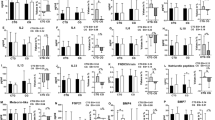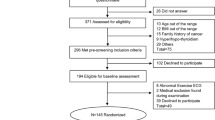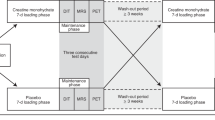Abstract
Background/objectives:
It has now been unequivocally demonstrated that humans possess functional brown adipose tissue (BAT) and that human BAT can be recruited upon chronic cold stimulation. Recruitment of BAT has been postulated as a potential strategy to counteract the current global obesity epidemic. Recently, it was shown in rodents that endurance exercise training could stimulate the recruitment of brown-like adipocytes within white adipose tissue (WAT) via exercise-induced myokines such as irisin (the cleaved circulating product of the type 1 membrane protein FNDC5) and interleukin-6 (IL-6). Our objective was to test whether endurance-trained athletes had increased cold-stimulated BAT activity and browning of subcutaneous WAT compared with lean sedentary males.
Subjects/methods:
Twelve endurance-trained athletes and 12 lean sedentary males were measured during 2 h of mild cold exposure to determine cold-induced BAT activity via [18F]fluorodeoxyglucose-positron emission tomography-computed tomography ([18F]FDG-PET-CT) scanning. Skeletal muscle FNDC5 expression, as well as plasma irisin and IL-6 levels were determined. In addition, a subcutaneous abdominal WAT biopsy was taken to measure gene expression of several markers for browning of WAT.
Results:
Cold-induced BAT activity was significantly lower in athletes, and no differences in gene expression of classical brown and beige adipocyte markers were detected in subcutaneous WAT between the groups. As expected, mRNA expression of FNDC5 in skeletal muscle was significantly higher in endurance athletes but plasma irisin and Il-6 levels were similar in both groups.
Conclusions:
These results indicate that chronic endurance exercise is not associated with brown and beige adipocyte recruitment; in fact endurance training appears to be linked to lower the metabolic activity of BAT in humans.
This is a preview of subscription content, access via your institution
Access options
Subscribe to this journal
Receive 12 print issues and online access
$259.00 per year
only $21.58 per issue
Buy this article
- Purchase on SpringerLink
- Instant access to full article PDF
Prices may be subject to local taxes which are calculated during checkout



Similar content being viewed by others

References
van Marken Lichtenbelt WD, Vanhommerig JW, Smulders NM, Drossaerts JM, Kemerink GJ, Bouvy ND et al. Cold-activated brown adipose tissue in healthy men. N Engl J Med 2009; 360: 1500–1508.
Vijgen GH, Bouvy ND, Teule GJ, Brans B, Schrauwen P, van Marken Lichtenbelt WD . Brown adipose tissue in morbidly obese subjects. PLoS One 2011; 6: e17247.
Cypess AM, Lehman S, Williams G, Tal I, Rodman D, Goldfine AB et al. Identification and importance of brown adipose tissue in adult humans. N Engl J Med 2009; 360: 1509–1517.
Ouellet V, Labbe SM, Blondin DP, Phoenix S, Guerin B, Haman F et al. Brown adipose tissue oxidative metabolism contributes to energy expenditure during acute cold exposure in humans. J Clin Invest 2012; 122: 545–552.
Chen KY, Brychta RJ, Linderman JD, Smith S, Courville A, Dieckmann W et al. Brown fat activation mediates cold-induced thermogenesis in adult humans in response to a mild decrease in ambient temperature. J Clin Endocrinol Metab 2013; 98: E1218–E1223.
Vosselman MJ, Brans B, van der Lans AA, Wierts R, van Baak MA, Mottaghy FM et al. Brown adipose tissue activity after a high-calorie meal in humans. Am J Clin Nutr 2013; 98: 57–64.
Wu J, Bostrom P, Sparks LM, Ye L, Choi JH, Giang AH et al. Beige adipocytes are a distinct type of thermogenic fat cell in mouse and human. Cell 2012; 150: 366–376.
Petrovic N, Walden TB, Shabalina IG, Timmons JA, Cannon B, Nedergaard J . Chronic peroxisome proliferator-activated receptor gamma (PPARgamma) activation of epididymally derived white adipocyte cultures reveals a population of thermogenically competent, UCP1-containing adipocytes molecularly distinct from classic brown adipocytes. J Biol Chem 2010; 285: 7153–7164.
Cypess AM, White AP, Vernochet C, Schulz TJ, Xue R, Sass CA et al. Anatomical localization, gene expression profiling and functional characterization of adult human neck brown fat. Nat Med 2013; 19: 635–639.
Lidell ME, Betz MJ, Dahlqvist Leinhard O, Heglind M, Elander L et al. Evidence for two types of brown adipose tissue in humans. Nat Med 2013; 19: 631–634.
Jespersen NZ, Larsen TJ, Peijs L, Daugaard S, Homoe P, Loft A et al. A classical brown adipose tissue mRNA signature partly overlaps with brite in the supraclavicular region of adult humans. Cell Metab 2013; 17: 798–805.
Boström P, Wu J, Jedrychowski M, Korde A, Ye L, Lo J et al. A PGC1-α-dependent myokine that drives brown-fat-like development of white fat and thermogenesis. Nature 2012; 481: 463–468.
Wickler SJ, Stern JS, Glick Z, Horwitz BA . Thermogenic capacity and brown fat in rats exercise-trained by running. Metabolism 1987; 36: 76–81.
Scarpace PJ, Yenice S, Tumer N . Influence of exercise training and age on uncoupling protein mRNA expression in brown adipose tissue. Pharmacol Biochem Behav 1994; 49: 1057–1059.
Segawa M, Oh-Ishi S, Kizaki T, Ookawara T, Sakurai T, Izawa T et al. Effect of running training on brown adipose tissue activity in rats: a reevaluation. Res Commun Mol Pathol Pharmacol 1998; 100: 77–82.
Shibata H, Nagasaka T . The effect of forced running on heat production in brown adipose tissue in rats. Physiol Behav 1987; 39: 377–380.
Xu X, Ying Z, Cai M, Xu Z, Li Y, Jiang SY et al. Exercise ameliorates high-fat diet-induced metabolic and vascular dysfunction, and increases adipocyte progenitor cell population in brown adipose tissue. Am J Physiol Regul Integr Comp Physiol 2011; 300: R1115–R1125.
Slocum N, Durrant JR, Bailey D, Yoon L, Jordan H, Barton J et al. Responses of brown adipose tissue to diet-induced obesity, exercise, dietary restriction and ephedrine treatment. Exp Toxicol Pathol 2013; 65: 549–557.
Seebacher F, Glanville EJ . Low levels of physical activity increase metabolic responsiveness to cold in a rat (Rattus fuscipes. PLoS One 2010; 5: e13022.
De Matteis R, Lucertini F, Guescini M, Polidori E, Zeppa S, Stocchi V et al. Exercise as a new physiological stimulus for brown adipose tissue activity. Nutr Metab Cardiovasc Dis 2013; 23: 582–590.
Elsen M, Raschke S, Eckel J . Browning of white fat: does irisin play a role in humans? J Endocrinol 2014; 222: R25–R38.
Knudsen JG, Murholm M, Carey AL, Biensø RS, Basse AL, Allen TL et al. Role of IL-6 in exercise training- and cold-induced UCP1 expression in subcutaneous white adipose tissue. PloS One 2014; 9: e84910.
Vosselman MJ, van der Lans AA, Brans B, Wierts R, van Baak MA, Schrauwen P et al. Systemic beta-adrenergic stimulation of thermogenesis is not accompanied by brown adipose tissue activity in humans. Diabetes 2012; 61: 3106–3113.
Bergstrom J, Hermansen L, Hultman E, Saltin B . Diet, muscle glycogen and physical performance. Acta Physiol Scand 1967; 71: 140–150.
Chomczynski P, Sacchi N . Single-step method of RNA isolation by acid guanidinium thiocyanate-phenol-chloroform extraction. Anal Biochem 1987; 162: 156–159.
Badeer HS . Resting bradycardia of exercise training: a concept based on currently available data. Recent Adv Stud Cardiac Struct Metab 1975; 10: 553–560.
van der Lans AAJJ HoeksJ, Brans B, GHEJ Vijgen, Visser MGW, Vosselman MJ et al. Cold acclimation recruits brown adipose tissue and increases non-shivering thermogenesis in humans. J Clin Invest 2013; 123: 3395–3403.
Raschke S, Elsen M, Gassenhuber H, Sommerfeld M, Schwahn U, Brockmann B et al. Evidence against a beneficial effect of irisin in humans. PLoS One 2013; 8: e73680.
Erickson HP . Irisin and FNDC5 in retrospect: an exercise hormone or a transmembrane receptor? Adipocyte 2013; 2: 289–293.
Bostrom PA, Fernandez-Real JM, Mantzoros C . Irisin in humans: recent advances and questions for future research. Metabolism 2014; 63: 178–180.
Huh JY, Panagiotou G, Mougios V, Brinkoetter M, Vamvini MT, Schneider BE et al. FNDC5 and irisin in humans. I. Predictors of circulating concentrations in serum and plasma and II. mRNA expression and circulating concentrations in response to weight loss and exercise. Metabolism 2012; 61: 1725–1738.
Norheim F, Langleite TM, Hjorth M, Holen T, Kielland A, Stadheim HK et al. The effects of acute and chronic exercise on PGC-1alpha, irisin and browning of subcutaneous adipose tissue in humans. FEBS J 2014; 281: 739–749.
Timmons JA, Baar K, Davidsen PK, Atherton PJ . Is irisin a human exercise gene? Nature 2012; 488: E9–10 discussion E10-11.
Pekkala S, Wiklund PK, Hulmi JJ, Ahtiainen JP, Horttanainen M, Pollanen E et al. Are skeletal muscle FNDC5 gene expression and irisin release regulated by exercise and related to health? J Physiol 2013; 591: 5393–5400.
Hecksteden A, Wegmann M, Steffen A, Kraushaar J, Morsch A, Ruppenthal S et al. Irisin and exercise training in humans: results from a randomized controlled training trial. BMC Med 2013; 11: 235.
Lee P, Linderman J, Smith S, Brychta R, Wang J, Idelson C et al. Irisin and FGF21 are cold-induced endocrine activators of brown fat function in humans. Cell Metab 2014; 19: 302–309.
Moreno-Navarrete JM, Ortega F, Serrano M, Guerra E, Pardo G, Tinahones F et al. Irisin is expressed and produced by human muscle and adipose tissue in association with obesity and insulin resistance. J Clin Endocrinol Metab 2013; 98: E769–E778.
Albrecht E, Norheim F, Thiede B, Holen T, Ohashi T, Schering L et al. Irisin—a myth rather than an exercise-inducible myokine. Sci Rep 2015; 5: 8889.
Dressendorfer RH, Smith RM, Baker DG, Hong SK . Cold tolerance of long-distance runners and swimmers in Hawaii. Int J Biometeorol 1977; 21: 51–63.
Kollias J, Boileau R, Buskirk ER . Effects of physical conditioning in man on thermal responses to cold air. Int J Biometeorol 1972; 16: 389–402.
Wijers SL, Saris WH, van Marken Lichtenbelt WD . Individual thermogenic responses to mild cold and overfeeding are closely related. J Clin Endocrinol Metab 2007; 92: 4299–4305.
Acknowledgements
We thank Reni van Erp, Jasper Most, Esther Phielix, Jos Stegen, Johanna Jörgensen, Esther Moonen-Kornips, Gert Schaart, Roel Wierts, Loek Wouters, Paul Schoffelen, Nancy Hendrix and Paul Menheere for their (technical) assistance during the study. Moreover, we thank our literature club for the helpful discussions. This work was financed by the Netherlands Organization for Scientific Research (TOP 91209037 to WDvML) and by the EU FP7 project DIABAT (HEALTH-F2-2011-278373).
Author information
Authors and Affiliations
Corresponding author
Ethics declarations
Competing interests
The authors declare no conflict of interest.
Rights and permissions
About this article
Cite this article
Vosselman, M., Hoeks, J., Brans, B. et al. Low brown adipose tissue activity in endurance-trained compared with lean sedentary men. Int J Obes 39, 1696–1702 (2015). https://doi.org/10.1038/ijo.2015.130
Received:
Revised:
Accepted:
Published:
Issue Date:
DOI: https://doi.org/10.1038/ijo.2015.130
This article is cited by
-
Muscle-to-organ cross-talk mediated by interleukin 6 during exercise: a review
Sport Sciences for Health (2024)
-
Absolute thermometry of human brown adipose tissue by magnetic resonance with laser polarized 129Xe
Communications Medicine (2023)
-
Physiological and molecular mechanisms of cold-induced improvements in glucose homeostasis in humans beyond brown adipose tissue
International Journal of Obesity (2023)
-
Fat as insurance, leanness as bodily display: did Ronald Reagan make us fat?
Journal of Bioeconomics (2023)
-
Batokines: Mediators of Inter-Tissue Communication (a Mini-Review)
Current Obesity Reports (2022)


